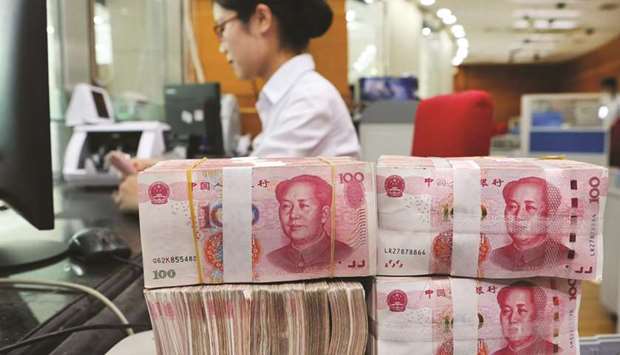China’s new bank loans rebounded in September after dipping in the two previous months, central bank data showed, but overall credit conditions stayed tight in an economy chilled by an ongoing tariff war with the United States.
Growth of outstanding total social financing, a reliable gauge of overall credit conditions, slowed to 10.6% in September from 10.8% in August, making it, according to Capital Economics, the weakest since 2005.
“We think that officials will soon need to turn to other measures, such as cuts to benchmark interest rates or a relaxation of constraints on off-budget local government borrowing, in order to shore up credit growth and economic activity,” Chang Liu, China Economist for Capital Economics in London, said in a note.
A Reuters poll published on Tuesday, however, showed most analysts expected the benchmark lending rate to be left unchanged at 4.35% through to the end of 2019, as the central bank focuses on other monetary policy levers, such as interbank rates.
A key factor behind the tight credit conditions is an ongoing crackdown on shadow financing, which has been falling since early 2017 and has put most strain on private firms traditionally shunned by big state banks.
Policymakers have in recent months unveiled measures to lower financing costs, cut taxes and fast-track more infrastructure projects, although analysts believe such modest stimulus may take time to put a floor under the slowing economy. Third quarter gross domestic product data due to be released tomorrow is expected to show growth at its weakest since the global financial crisis, due in part to the impact of the trade war with the United States, according to a Reuters poll.
To stimulate bank lending, the People’s Bank of China (PBoC) has cut reserve requirements for lenders four times this year, with the latest cut taking effect on October 15.
The data released yesterday showed Chinese banks extended 1.38tn yuan ($199.25bn) in net new yuan loans in September, more than analysts had expected and up from the previous month.
Total new bank loans in the first nine months of the year jumped 17.7% from a year earlier to 13.14tn yuan, and were on track to make a record year, eclipsing last year’s 13.53tn yuan, even though rising defaults have made banks more cautious. But the increased lending barely compensates for shrinking “shadow” loans, one of the major targets of regulators as they seek to curb systemic financial risks.
Combined trust loans, entrusted loans and undiscounted bankers’ acceptances, which are common forms of shadow banking finance, fell by 289bn yuan in September, following a drop of 267.4bn yuan in August and a slide of 1.75tn yuan in the first seven months.
China’s total social financing (TSF), a broad measure of credit and liquidity in the economy, rose to 2.21tn yuan ($319.08bn) in September from 1.52tn yuan in August.
TSF includes off-balance sheet forms of financing that exist outside the conventional bank lending system, such as initial public offerings, loans from trust companies and bond sales.
The PBoC has revised the way it calculates TSF by adding local government special bonds issuance from September, which boosted growth rates.
Broad M2 money supply grew 8.3% in September from a year earlier, meeting analysts expectations and just slightly higher than the 8.2% posted in August, central bank data showed yesterday.
Outstanding yuan loans grew 13.2% from a year earlier, matching expectations and August’ s rise.
The steadying loan growth offered an early sign that recent policy easing may be having an effect, but regulatory tightening continued to weigh on shadow financing, Chang said. In September, household loans, mostly mortgages, rose to 754.4bn yuan from 701.2bn yuan in August, while corporate loans rose to 677.2bn yuan in September from 612.7bn yuan a month earlier, according to Reuters’ calculations based on central bank data.
Central bank governor Yi Gang said on Sunday he still sees plenty of room for adjustment in interest rates and the reserve requirement ratio (RRR), as downside risks from trade tensions with the United States remain significant.

An employee counts 100-yuan notes at a bank in Nantong in Jiangsu province. China’s total new bank loans in the first nine months of the year jumped 17.7% from a year earlier to 13.14tn yuan, and are on track to make a record year.
